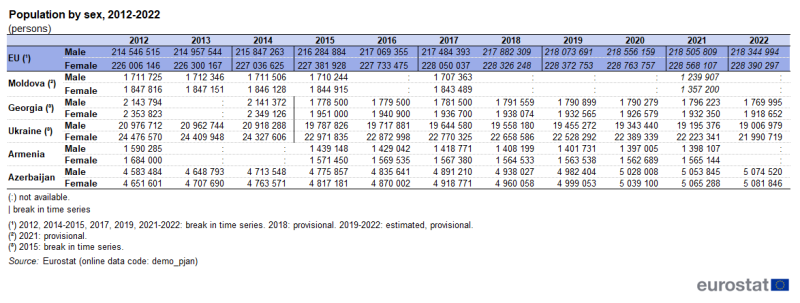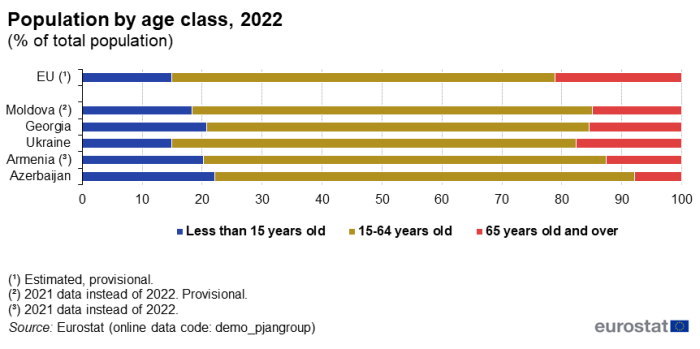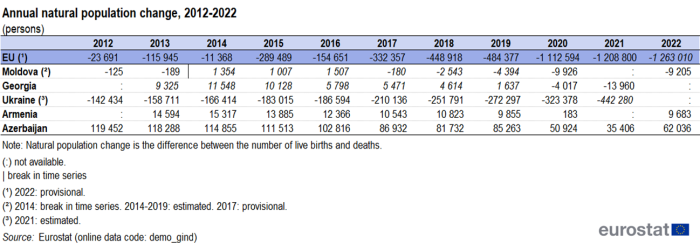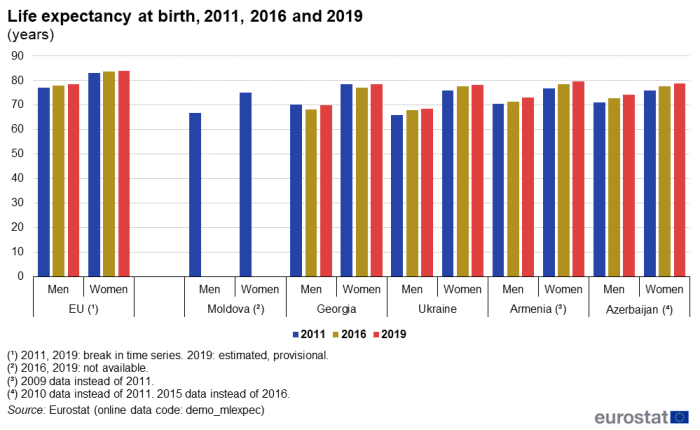Population in European Neighbourhood East countries
Data extracted in February 2024.
Planned article update: March 2025.
Highlights
Among the European Neighbourhood Policy-East countries in 2022, people aged 65 years and over made up between 7.9 % in Azerbaijan and 17.6 % in Ukraine of the total population. In the EU, people in this age group accounted for 21.1 % of the total population.
Among the European Neighbourhood Policy-East countries in 2019, life expectancy for men ranged from 68.4 years in Ukraine to 74.3 years in Azerbaijan whereas for women it ranged from 78.3 years in Ukraine and 79.7 years in Armenia. In the EU, life expectancy was 78.5 years for men and 84.0 years for women.
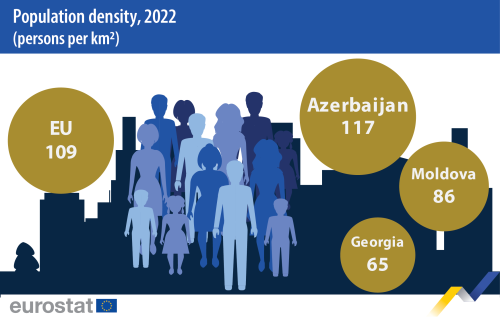
This article is part of an online publication. It presents information on five European Neighbourhood Policy-East (ENP-East) countries, namely, Armenia, Azerbaijan, Georgia, Moldova and Ukraine, compared with the European Union (EU). Georgia, Moldova and Ukraine are also candidate countries, with the European Council having granted Moldova and Ukraine candidate status on 22 June 2022 and Georgia on 14 December 2023. This article does not contain any data on Belarus, as statistical cooperation with Belarus has been suspended as of March 2022.
Data shown for Georgia exclude the regions of Abkhazia and South Ossetia over which the government of Georgia does not exercise control. The data managed by the National Bureau of Statistics of the Republic of Moldova does not include data from Transnistria over which the government of the Republic of Moldova does not exercise control. Since 2014, data for Ukraine generally exclude the illegally annexed Autonomous Republic of Crimea and the City of Sevastopol and the territories which are not under control of the Ukrainian government. Data on Ukraine for the year 2022 is limited due to exemption under the martial law from mandatory data submission to the State Statistics Service of Ukraine, effective as of 3 March 2022, following Russia's war of aggression against Ukraine.
Statistics on changes in the population and its structure are increasingly used to support policy making and provide an opportunity to monitor demographic behaviour within an economic, social and cultural context. Aside from basic data on population levels and structure, this article also provides information on population density, natural change in the population, migration, life expectancy, and students at different education levels.
Full article
Population structure by age and by sex
Data for the ENP-East countries and the EU on the total population by sex for the years 2012-2022 is shown in Table 1. Data for 2022 are available only for Azerbaijan, Georgia, Ukraine and the EU. The number of women in the total population of the EU and ENP-East countries is slightly higher than the number of men. Whereas women made up 51.1 % of the population in the EU in 2022, they made up 53.6 % in Ukraine, 52.8 % in Armenia (2021 data), 52.3 % in Moldova (2021 data) and 52.0 % in Georgia. In Azerbaijan, the gender balance in the population was even at 50.0 % each for men and women in 2022.
Azerbaijan was the only one of the ENP-East countries in which the population increased between 2012 and 2022. Azerbaijan's population grew by 10.0 % over this period, from 9.2 million to 10.2 million, with the male part of the population growing somewhat stronger than the female. For the other ENP-countries, the population declined relatively rapidly. The population fell from 3.6 million to 2.6 million 2012-2021 in Moldova (-27.0 %), from 4.5 million to 3.7 million 2012-2022 in Georgia (-18.0 %; nevertheless, in 2015 there was a break in time series), from 45.5 million to 41.0 million 2012-2022 in Ukraine (-9.8 %; nevertheless, in 2015 there was a break in time series) and from 3.3 million to 3.0 million 2012-2021 in Armenia (-9.5 %). In Moldova and Armenia, the male population fell stronger than the female population, while the opposite was the case for Georgia and Ukraine.
Over the period 2012-2022, the EU population grew slightly, from 440.6 million to 446.7 million (+1.4 %), with the number of men increasing stronger than that of women.
Figure 1 shows the age structure of the population of the ENP-East countries and the EU in 2022. The share of the elderly population, defined here as persons aged 65 years and over, accounted for 12.6 % of the population in Armenia (2021 data), 7.9 % in Azerbaijan, 15.5 % in Georgia, 14.9 % in Moldova (2021 data, provisional) and 17.6 % in Ukraine. In comparison, people aged 65 years and over made up 21.1 % of the total population of the EU in 2022, a higher proportion than in any of the ENP-East countries. This reflects, among other factors, greater longevity among the EU population.
At the other end of the age spectrum, the shares of young people in the total populations of the ENP-East countries were mostly similar to the EU average. The highest proportion was recorded in 2022 for Azerbaijan, where those aged less than 15 years made up 22.2 % of the population. In Georgia, people aged less than 15 years accounted for 20.8 %. In Armenia, 20.2 % of the total number of inhabitants were aged under 15 years (2021 data). In Moldova, the share (2021 data, provisional) was 18.3 % and in Ukraine 14.9 %. Young people accounted for 15.0 % of the EU's population in 2022.
The EU's population is ageing, as consistently low birth rates and higher life expectancy transform the shape of its age pyramid. As a result, the proportion of people of working age in the EU is shrinking, while the relative number of those retired is expanding. This will, in turn, lead to an increased burden on those of working age to provide for the social expenditure required by the ageing population for a range of services. These issues also apply to an extent in those ENP-East countries that have a high proportion of persons aged over 65 years in their populations.
Population density
Data on population density, measured in inhabitants per square kilometre, is illustrated in Figure 2 for the ENP-East countries and compared with the EU.
Among the ENP-East countries, Azerbaijan had the highest population density in 2022, at 117.0 inhabitants per square kilometre. In 2012, its population density stood at 107.0, close to the population density in the EU. Between 2012 and 2022, the population density remained mostly stable in the EU (from 107.3 in 2012 to 108.9 in 2022), and in the ENP-East countries Armenia (from 101.6 in 2012 to 99.6 in 2021 data) and Georgia (from 65.4 in 2012 to 64.5 in 2022).
The most recent data available for Ukraine is for the year 2014, when its population density was 75.3 inhabitants per square kilometre. There was a substantial break in the time series on population density for Moldova in 2014, with a population density of 117.2 in 2012 and 2013 falling to a new level of 94.5 in 2014 (population density is based on resident population from 2014 onwards). The population density has fallen strongly since, to 85.8 in 2022.

(inhabitants per square kilometre)
Source: Eurostat (demo_r_d3dens) and Eurostat data collection.
Annual natural change
The natural population change is the difference between the number of live births and deaths during a given period, usually one year. Available data for the ENP-East countries is shown in Table 2 for the period 2012-2022.
Between 2012 and 2022, Azerbaijan recorded positive natural population change, i.e. more live births than deaths, each year. Throughout this period, this natural population growth was the highest among the ENP-East countries each year. Azerbaijan saw natural population growth of more than 100 000 persons each year between 2012-2016, ranging from 119 452 in 2012 to 102 816 persons in 2016. Its lowest population growth of the period was seen in the two years characterised by the Covid-19 pandemic (2020-2021), with growth by 50 924 persons in 2020 and 35 406 in 2021.
Armenia also registered natural population growth throughout the period 2013-2022 (2012 and 2021 data not available), in the range between 14 594 (2013) and 9 683 (2022), with an outlier at just 183 in 2020 at the midst of the Covid-19 pandemic; 2021 data are not available for Armenia. Georgia is another country that saw natural population growth during the period 2013-2019, prior to the Covid-19 pandemic, with growth ranging between 11 548 (2014, estimated) and 1 637 (2019, estimated). During the pandemic in 2020 and 2021, Georgia recorded more deaths than live births, with negative natural population changes of -4 017 and -13 960, respectively. Moldova saw an uneven trend in natural population change 2012-2022, with slight falls in 2012 and 2013 (-125 and -189, respectively). However, due to a break in series in 2014, these figures cannot be directly compared with later years. In 2014-2016, Moldova registered moderate positive population growth ranging between 1 007 (2015) and 1 507 in 2016, before a negative population change in each subsequent year (estimated 2014-2019; 2021 not available). The strongest negative changes were -9 926 in 2020 and -9 205 in 2022.
Ukraine stands out with a strong negative natural population change throughout the period 2012-2021 (2022 not available), with far more deaths than live births. Its natural population change stood at -142 434 in 2012 and fell each subsequent year, to -442 280 in 2021.
For the EU, the annual natural change followed a constant decrease between 2012 and 2022, from -23 691 in 2012 to -1 263 010 in 2022 (provisional), reflecting its aging population and moderate birth rates in several Member States. The negative change accelerated during the Covid-19 pandemic, falling from -484 377 in 2019 to -1 112 594 in 2020 and -1 208 800 in 2021, but persisted at this low level also in 2022.
Annual net migration
Besides the natural population change, net migration is the other factor leading to increase or decrease in the population. The annual net immigration is the difference between the number of immigrants (people coming into an area) and the number of emigrants (people leaving an area). Data for the ENP-East countries and the EU is shown in Table 3 for 2012 to 2022.[1]
Comparing annual net immigration over the period 2012-2022 (or the period for which data is available) as shown in Table 3, emigration figures mainly exceeded immigration figures in Moldova, Georgia and Armenia, while immigration mainly exceeded emigration in the EU, Ukraine and Azerbaijan (excluding 2022). It should be noted that, due to break in time series limiting comparability over time and missing data for individual years, it is difficult to discern long-term trends for several of the ENP-East countries.
In the period 2014-2020, estimated net migration was negative in Moldova, with figures ranging from -21 293 in 2015 to -49 408 in 2017. In 2022, net immigration fell further, to a new low of -81 766 (estimated). In Georgia, net migration plus statistical adjustments exhibited a very high negative figure in 2014. This originated from the 2014 General Population Census results, which revealed the necessity of re-estimation of basic demographic data. This resulted in a major break in the time series in 2014. In subsequent years, net migration in Georgia has varied with net immigration in 2020 (+15 732), close to zero migration in 2016 (+176), and net emigration in the other years, peaking at -25 966 in 2021; 2022 data are not available.
In the period for which data are available for Armenia, 2013 to 2020 (2014 not available), net migration was generally negative, with net migration at its lowest level at -25 906 in 2015. The exception was the last year available, 2020, where net migration stood at +3 374. In contrast, net migration for Azerbaijan was generally low, with net immigration throughout the period 2012-2021, with annual migration ranging between +388 (2019) and +2 348 (2013); 2022 data are not available.
In Ukraine, immigration exceeded emigration each year in the period 2012-2021. The highest net migration numbers were recorded in 2012 and 2013, with 61 844 and 31 913, respectively. Data for 2014 is not available, but since 2014, data for Ukraine generally exclude the illegally annexed Autonomous Republic of Crimea and the City of Sevastopol and the territories which are not under control of the Ukrainian government. The available data for the period 2012-2021 indicate a net immigration of between 9 316 (2020) and 21 512 (2019). Data for 2022, following Russia's war of aggression against Ukraine, is not available.
From 2012 to 2022, there has been significant net migration to the EU, with positive figures each year. Years with notable figures were 2013, registering net immigration of 1.5 million persons, 2015 and 2019, both with 1.4 million, and 2018 with 1.3 million. However, following Russia's war of aggression against Ukraine in 2022, net migration to the EU climbed to close to 4.0 million persons in 2022.
Life expectancy at birth
Globally, life expectancy at birth has risen rapidly over the last century, reflecting reductions in infant mortality, rising living standards, improved lifestyles and better education, as well as advances in healthcare and medicine.
In 2019, life expectancy at birth continued to be higher for women than for men, both within the EU and across all ENP-East countries, as shown in Figure 6. The life expectancy for men in the ENP-East countries ranged from 68.4 years in Ukraine to 74.3 years in Azerbaijan. The life expectancy for women was between 78.3 years in Ukraine and 79.7 years in Armenia.
Over the period 2011-2019, the greatest improvement in the region in life expectancy for men occurred in Azerbaijan, increasing by 3.1 years (2010-2019), while Georgia recorded a decrease of 0.3 years. The greatest improvement in life expectancy for women, increasing by 3.0 years, was recorded in Armenia (2009-2019). In contrast, it declined by 0.2 years in Georgia.
Life expectancy in the EU was 78.5 years for men and 84.0 years for women in 2019 (estimated, provisional data). For both men and women, this was higher than in any of the ENP-East countries during the period analysed. A break in the EU's time series data means that later data is not strictly comparable with 2011. Noting this, in the EU, life expectancy for men increased by 1.5 years between 2011 and 2019, while that of women increased by 0.9 years.
Students by education level
The share of students at different education levels for the ENP-East countries and the EU in 2012 and 2022 are shown as percentage of the total number of students in Figure 4.
Overall, the total number of students increased substantially from 2012 to 2022 in Azerbaijan (+21.8 %) and Georgia (+20.0 %; sum of available data), while it fell by 12.9 % in Moldova. Compared to 2012, the total number of students in Ukraine had fallen by 1.4 million to 7.0 million in 2022 (-16.9 %), following Russia's war of aggression. Whereas the number of students in primary education increased (+8.7 %) over the period, the number of students fell for all other education levels. From 2012 to 2022, the number of students in tertiary education fell by 1.0 million (-41.1 %).
The distribution of students across the different education levels largely reflects the age structure among young people in the respective countries. In 2022, 27.4 % of students in Moldova attended lower secondary education (+0.4 percentage points (pp) compared to 2012), 23.5 % primary education (+3.0 pp) and 23.4 % (+3.1 pp) in early childhood or other pre-primary education. In Georgia 36.5 % of students attended primary education (+0.2 pp) in 2022, while 16.3 % attended early childhood or other pre-primary education (+1.9 pp). Reflecting the sharp fall in the total number of students, the share of students in tertiary education in Ukraine fell to 20.1 % in 2022 (-8.4 pp). Armenia saw the share of students in lower secondary education rise to 31.3 % in 2022, an increase of 6.1 pp compared to 2012, while the share of students in primary education rose to 29.3 % (+1.9 pp). Despite the overall growth in the number of students in Azerbaijan from 2012 to 2022, the number of students in upper secondary education fell by 63 thousand, resulting in a decrease in the share of students at this level to 14.1 % (-6.6 pp). 29.3 % of the students in Azerbaijan attended primary education in 2022 (+2.1 pp).
In the EU, the total number of students at all levels of education was not reported for 2012; in 2022, the number of students in the EU was 91.1 million. The number of students in tertiary education in the EU grew by 1.3 million (+7.5 %) over the period, with their share in the total increasing to 20.3 % (+1.8 pp). However, students in primary education still made up the largest share of the total in 2022, with 25.4 % (-0.1 pp), with lower secondary (20.7 %; +0.7 pp) and upper secondary education (19.8 %; +0.5 pp) also accounting for large portions of the students.
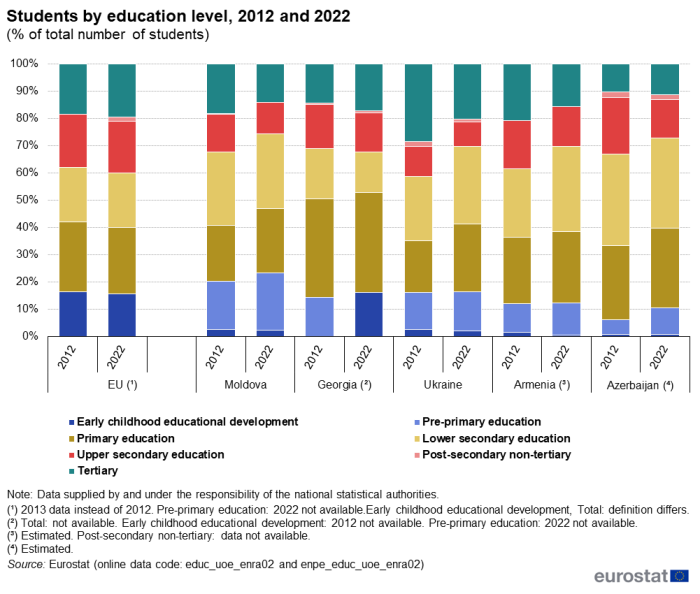
(% of total number of students)
Source: Eurostat (educ_uoe_enra02) and (enpe_educ_uoe_enra02)
Source data for tables and graphs
Data sources
Eurostat provides a wide range of demographic data, including statistics on populations at national and regional level, as well as for various demographic events influencing the size, the structure and the specific characteristics of these populations. Eurostat collects data from EU countries and other countries participating in its demography data collection exercise, including the ENP-East countries. The recommended definition is the 'usual resident population' and represents the number of inhabitants on 1 January of the year in question (or, in some cases, on 31 December of the previous year).
Tables in this article use the following notation:
| Value in italics | data value is forecast, provisional or estimated and is therefore likely to change; |
| : | not available, confidential or unreliable value. |
Context
On 2 July 2021, the European Commission and the EU High Representative for Foreign Affairs and Security Policy presented the Eastern Partnership: a Renewed Agenda for cooperation with the EU's Eastern partners. This agenda is based on the five long-term objectives, with resilience at its core, as defined for the future of the Eastern Partnership (EaP) in the Joint Communication Eastern Partnership policy beyond 2020: Reinforcing Resilience – an Eastern Partnership that delivers for all in March 2020. It is further elaborated in the Joint Staff Working Document Recovery, resilience and reform: post 2020 Eastern Partnership priorities, amongst others defining the 'Top Ten Targets for 2025'. The Eastern Partnership's agenda for recovery, resilience and reform is underpinned by an 'Economic and Investment Plan for the Eastern Partnership (EaP): Investing in resilient and competitive economies and societies' (Annex I of the Joint Staff Working Document). More detailed overviews are given in a Factsheet on the Eastern Partnership Joint Communication, presenting the policy objectives and the specific priorities, as well as in a Factsheet on EU-Eastern Neighbourhood flagship projects 2023-2024.
The Joint Declaration of the Eastern Partnership Summit 'Recovery, Resilience and Reform' of 15 December 2021 reaffirmed the strong commitment to a strategic, ambitious and forward-looking Eastern Partnership.
At the Eastern Partnership Foreign Affairs Ministerial meeting of 11 December 2023, the EU, member states and partners declared that they will step up their efforts to implement the Eastern Partnership's agenda for recovery, resilience and reform, as well as tackling challenges related to the ongoing consequences of the Russian war of aggression against Ukraine for the entire region.
In cooperation with its ENP partners, Eurostat has the responsibility 'to promote and implement the use of European and internationally recognised standards and methodology for the production of statistics, necessary for developing and monitoring policy achievements in all policy areas'. Eurostat undertakes the task of coordinating EU efforts to increase the statistical capacity of the ENP countries. Additional information on the policy context of the ENP is provided on the website of Directorate-General European Neighbourhood Policy and Enlargement Negotiations (NEAR).
Direct access to
Books
Factsheets
- Basic figures on the European Neighbourhood Policy-East countries — 2023 edition
- Basic figures on the European Neighbourhood Policy-East countries — 2022 edition
- Basic figures on the European Neighbourhood Policy-East countries — 2021 edition
Leaflets
- Basic figures on the European Neighbourhood Policy — East countries — 2020 edition
- Basic figures on the European Neighbourhood Policy — East countries — 2020 edition
- Basic figures on the European Neighbourhood Policy — East countries — 2019 edition
- Basic figures on the European Neighbourhood Policy — East countries — 2018 edition
- Basic figures on the European Neighbourhood Policy — East countries — 2016 edition
- Basic figures on the European Neighbourhood Policy — East countries — 2015 edition
- Basic figures on the European Neighbourhood Policy — East countries — 2014 edition
- Demographic statistics for the European Neighbourhood Policy — East countries — 2019 edition
- General and regional statistics
- Non EU countries (noneu)
- Eastern European Neighbourhood Policy countries (ENP-East) (enpe)
- Population and social conditions (enpe_pop)
- Eastern European Neighbourhood Policy countries (ENP-East) (enpe)
- Non EU countries (noneu)
- Eastern European Neighbourhood Policy countries (ENP-East) (ESMS metadata file — enpe_esms)
- European External Action Service (EEAS): European Neighbourhood Policy (ENP) and Eastern Partnership (EaP)
- Directorate-General European Neighbourhood Policy and Enlargement Negotiations (DG NEAR): European Neighbourhood Policy (ENP) and Eastern Partnership (EaP).
- Joint Communication JOIN(2020) 7 final: Eastern Partnership policy beyond 2020: Reinforcing Resilience - an Eastern Partnership that delivers for all (18 March 2020)
- Joint Staff Working Document SWD(2021) 186 final: Recovery, resilience and reform: post 2020 Eastern Partnership priorities (2 July 2021)
- Joint Declaration of the Eastern Partnership Summit: 'Recovery, Resilience and Reform' (15 December 2021)
Notes
- ↑ In the context of the annual demographic balance, Eurostat produces net migration figures by taking the difference between total population change and natural change; this is referred to as net migration plus statistical adjustment.
